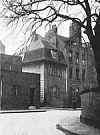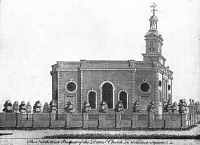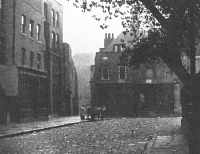A casual visitor to whom the region of the London Docks is unfamiliar, might well be surprised at discovering by chance Wellclose Square, which lies between that part of Cable Street formerly called Knockfergus, and St. George's Street, a name veiling that of Ratcliff Highway. The surprise might even be experienced by not a few other persons having a daily passing acquaintance with the neighbourhood, if they would purposely turn aside from their customary walk in order to see some relics of a once highly respectable residential quarter of the Metropolis, that has suffered much at the hands of man and time. In what may now seem to be an out-of-the-way place, but which long ago was a scene of busy social and family life, there remain a number of eighteenth-century houses, several of which, including the old Court House, were built about 1700. These, which have been refronted in later times, have exteriors that conceal their age. Other houses near by, that were constructed some years afterwards, not having been so transformed, have an older look about them.
In the drawing by Mr. Hanslip Fletcher, which forms the frontispiece to this issue of THE COPARTNERSHIP HERALD, the prospect of the west side of the Square is presented. The line of houses will not fail to please the eye and to engage the imagination, while the little cottage, and another wooden house that stands behind it, will be observed with interest. In the distance two houses can be seen (those with the decorations in relief, symbolising the Arts and Sciences) that were once occupied by the Danish Embassy. Except in those times when children are about, the general every day aspect is that of dullness, if not dejection. Ninety years ago it presented itself differently to a writer, who, in referring to the cheerful scenes of life and animation to be found in several places in London, observed that " This is especially the case with Well Close Square: probably the elastic spirits of the gallant tars, who were the earliest occupants, lent a light-heartedness to the very atmosphere that has never since deserted it."
 The
Square is commonly spoken of as being in St. George's-in-the-East, but actually it is only partly
in that parish, for its extent is also shared by Whitechapel and Wapping. It once possessed
the distinction of being within the Precinct of Well Close, a Liberty of the Tower of London.
Its origin as the Precinct or Liberty is to be traced in its having been in early times an area
deemed to be outside the County of Middlesex and in the suburb of Portsoken Ward, over which
the City of London exercised control.
The
Square is commonly spoken of as being in St. George's-in-the-East, but actually it is only partly
in that parish, for its extent is also shared by Whitechapel and Wapping. It once possessed
the distinction of being within the Precinct of Well Close, a Liberty of the Tower of London.
Its origin as the Precinct or Liberty is to be traced in its having been in early times an area
deemed to be outside the County of Middlesex and in the suburb of Portsoken Ward, over which
the City of London exercised control.
The privileges it then possessed were not identical with those that were afterwards attached to it. By Letters Patent, in 1688, James II definitely separated the Precinct (also referred to as the "Tower Ground ") from the City, and included it among the Tower Liberties, although the Tower had no tenure of land therein. To the governance of the Tower was granted authority for the maintenance of law and order (that is, the King's Peace), to try by appointed magistrates sitting with the Governor of the Tower, before whom were to be brought all persons within the Tower Liberties accused of treason and felony as well as of minor offences, and criminals were to be committed to Newgate for safe custody. It was also a Court of Record and Request, which had functions similar to those of our modern County Court for the recovery of small debts. It was ordered that there should be a Court House with a prison, and these buildings were subsequently erected in Well Close. The prison, to give the correct designation, was the gaol bf the Tower Royalty - not of the Tower Hamlets and in it were confined the insolvent debtors.
According to custom, Well Close, with the other Liberties, was perambulated triennially on Ascension Day - the last occasion being in 1897. The Lieutenant of the Tower then came, accompanied by an escort of Tower warders, followed by officials and schoolboys wearing "ribbons red, white and blue on their bosoms," and carrying willow wands. These boys were the sons of the soldiers quartered at the Tower. Then were beaten the bounds of a jurisdiction that had become devoid of real significance, but the ceremony served to keep in remembrance the privileges that once pertained to the Tower and had ceased to be effective owing to the changes wrought by successive enactments relating to the administration of the law, police, and local government.
The Square had already been formed by 1694, for it was then alluded to as "Well Close now known as Marine Square," a name that it is supposed was given to it because the first inhabitants were connected with the sea. The description Wellclose Square does not appear until nearly forty years afterwards.
 A
notable occurrence was the building of a church in 1696 at the expense of King Christian V of
Denmark for the use of Danish people, some of whom lived in the riverside neighbourhood,
where they conducted trade with their country, and for others who made occasional visits to
our shores. The edifice, which stood in the middle of the square, has been described as "a commodious
and elegant structure, and though the architect appears to have under stood ornaments, he has
not been too lavish in the use of them." The architect was Caius Gabriel Cibber (1630-1700),
a Danish sculptor, who, settling in England, received in due course marks of favour from William
III. His celebrated statues of "Raving Madness" and "Melancholy," which once adorned Bethlehem
Hospital, are now to be found in the Guildhall Museum. Another specimen of his work are the
bas-reliefs on the plinth of the Monument. The sculptor's son was the well-known Colley Cibber
(1671-1757), poet laureate and actor-dramatist, who has his last resting-place in Westminster
Abbey, but whose father and mother were buried in a vault beneath this church which was pulled
down in 1869, when their coffins were removed into the crypt and there bricked up. The site
of the Danish church is now occupied by St. Paul's School, Nursery and Mission.
A
notable occurrence was the building of a church in 1696 at the expense of King Christian V of
Denmark for the use of Danish people, some of whom lived in the riverside neighbourhood,
where they conducted trade with their country, and for others who made occasional visits to
our shores. The edifice, which stood in the middle of the square, has been described as "a commodious
and elegant structure, and though the architect appears to have under stood ornaments, he has
not been too lavish in the use of them." The architect was Caius Gabriel Cibber (1630-1700),
a Danish sculptor, who, settling in England, received in due course marks of favour from William
III. His celebrated statues of "Raving Madness" and "Melancholy," which once adorned Bethlehem
Hospital, are now to be found in the Guildhall Museum. Another specimen of his work are the
bas-reliefs on the plinth of the Monument. The sculptor's son was the well-known Colley Cibber
(1671-1757), poet laureate and actor-dramatist, who has his last resting-place in Westminster
Abbey, but whose father and mother were buried in a vault beneath this church which was pulled
down in 1869, when their coffins were removed into the crypt and there bricked up. The site
of the Danish church is now occupied by St. Paul's School, Nursery and Mission.
 On
the south side of the Square, at the corner of Neptune Street, is the old Court House, now occupied
as business premises, but for some time before the Great War used as a German club. The
building, which contains its original staircase of a date about 1700, has no outward features
to attract attention. In the nineteenth century it served the purposes of several official functions
connected with the Tower Hamlets. Here, for instance, that important body, the Commissioners
of Ratcliff Pavement, at one time held their meetings, and the Revising Barrister sat to revise
the Parliamentary electorate. More closely associated with it, however, were the sessions of
the Bench of Licensing Magistrates of the Tower Division. Adjacent to the Court House, and intercommunicating
with it, was a public-house known as " The Cock and Neptune," the landlord of which acted as
gaoler to the Court when the Justices were sitting. Perhaps he held that office by reason of
long custom, for his predecessors certainly performed the duties of that post when prisoners
were in the gaol, which was part and parcel of the premises. The public-house and the prison
have been demolished, and the wooden cells have been re-erected at the London Museum at Stafford
House, St. James's, where can be seen an effigy of a poor emaciated debtor lying miserably on
a litter of straw with a rat waiting for the food that does not come. From the facile pen and
fertile mind of the late G. R. Sims the following somewhat imaginative account is given of the
exhibit:-
On
the south side of the Square, at the corner of Neptune Street, is the old Court House, now occupied
as business premises, but for some time before the Great War used as a German club. The
building, which contains its original staircase of a date about 1700, has no outward features
to attract attention. In the nineteenth century it served the purposes of several official functions
connected with the Tower Hamlets. Here, for instance, that important body, the Commissioners
of Ratcliff Pavement, at one time held their meetings, and the Revising Barrister sat to revise
the Parliamentary electorate. More closely associated with it, however, were the sessions of
the Bench of Licensing Magistrates of the Tower Division. Adjacent to the Court House, and intercommunicating
with it, was a public-house known as " The Cock and Neptune," the landlord of which acted as
gaoler to the Court when the Justices were sitting. Perhaps he held that office by reason of
long custom, for his predecessors certainly performed the duties of that post when prisoners
were in the gaol, which was part and parcel of the premises. The public-house and the prison
have been demolished, and the wooden cells have been re-erected at the London Museum at Stafford
House, St. James's, where can be seen an effigy of a poor emaciated debtor lying miserably on
a litter of straw with a rat waiting for the food that does not come. From the facile pen and
fertile mind of the late G. R. Sims the following somewhat imaginative account is given of the
exhibit:-
"These cells form part of the old prison or house of detention which was at one time connected with the High Court of the Liberties of the Tower in Wellclose Square, a Court to which the Duke of Wellington was a frequent visitor when Constable of the Tower.
"The Prison, which was in Neptune Street, was originally one in which poor debtors were confined for indefinite periods. When the law did away with indefinite imprisonment for small debts many of the debtors' prisons were used to accommodate criminals awaiting trial. Neptune Street Prison was one of them. The early use to which the prison was put is shown by an inscription which still remains in one of the cells:-
"'Please to remember the poor debtors. 1758.'
"Early in the eighteenth century Neptune Street Prison became familiarly known in the district as 'The Sly House.' It derived its suggestive title from the fact that many persons were seen to enter it and were never seen to leave it. There was a subterranean passage that led from the prison to the Tower and the Docks, and it was along this subterranean passage that prisoners were marched on their way to the convict ship Success.
"During the Peninsular campaign many prisoners of war were confined in these cells. They were lodged there previous to being sorted out and despatched to the County Gaols. This accounts for the number of foreign nanies which are found among the English and Irish autographs scrawled on the wall and carved on the forms and benches.
"Fifty years ago the disused prison was turned into a freak museum. Then a portion of it became a public-house, the landlord using the cells for storage purposes, and later on the place became a common lodging-house. That was its condition when these historic cells were acquired by the London Museum."
However interesting this account may appear, the particulars in it are not true to known facts. The story of the underground communication with the Tower is purely fictitious, and that stated to have led to the Docks is equally so, for they were not then in existence. The transportation of convicts in the ship Success took place in the nineteenth century, when there were no prisoners in Neptune Street gaol. It is incredible, also, on account of its small size, that any prisoners of. war were ever confined there. John Howard, the philanthropist, who visited the prison in about 1777, reported that he saw only a few prisoners. On the premises were a number of men who had come in for a game of skittles, for in those days debtors' prisons were the resort of idle and dissolute persons, who came there to drink and play, and were encouraged to do so by the keepers in order to increase the profits of their office.
Wellclose Square was not an undesirable neighbourhood to live in, for it was a favourite place of residence for the families of well-to-do men whose business interests were in the locality, or who were concerned with the river and sea. It did not fall from its place of high esteem until the middle of the last century, when it began gradually to decline owing to the influence of the foreign shipping at the London and the St. Katherine Docks. In its happiest years a watchman went his round all through the night and hourly cried "All's well!" to those abed, to whom the sense of security was made the more by the knowledge that the fire engine kept on the north side of the church was ready on the first alarm.
by Sydney Maddocks
